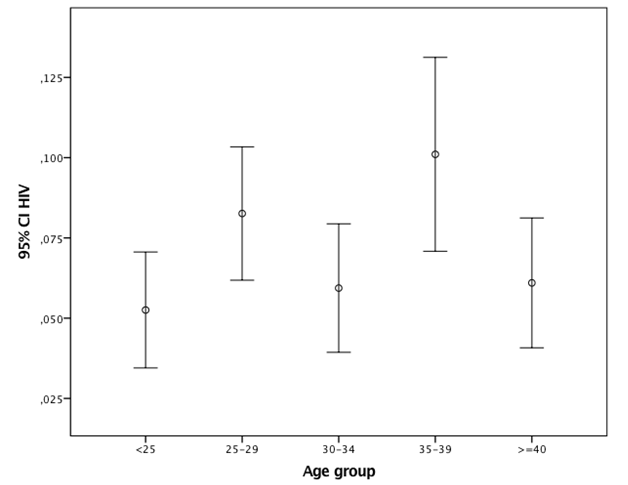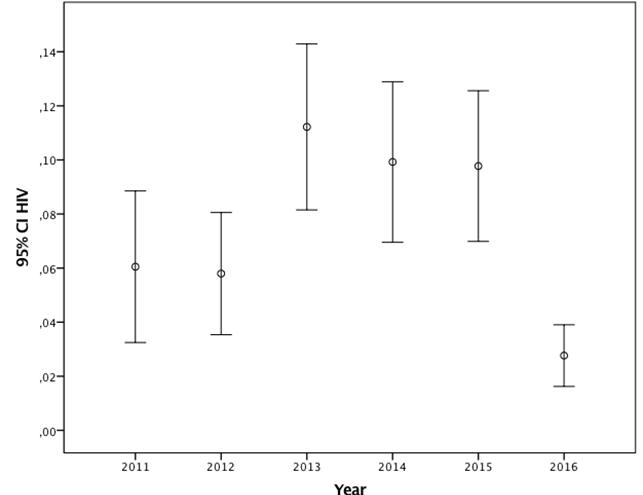Trends in Human Immunodeficiency Virus Type 1/2 Prevalence among Young Adult Blood Donors, from 2011 to 2016, Attending a Private Clinic in Angola. Retrospective Study of Prevalence
Introduction: The pandemic of the human immunodeficiency virus (HIV) continues to pose an enormous threat on a global scale. It is considered a public health problem worldwide, particularly in developing countries. It is therefore crucial to screen individuals at risk of infection which are common in Africa that is important to screen blood donations for this infection. This study aims to identify HIV positive 1/2 antibody in blood donors.
Objectives: It’s about epidemiology study of prevalence, to identify HIV positive 1/2 antibody in blood donors.
Methodology: Epidemiology Study of Prevalence. A database of positive markers for HIV 1/2 antibody/antigen in blood donors was used, screened between 2011 and 2016.The analysis was carried out using the statistical data analysis program SPSS® v.22.0 (Statistical Package for the Social Sciences).
Results: The total prevalence of HIV was 191 (7%) donors out of 2734 presented positive results for the human immunodeficiency virus antibody. The majority (86%) 164 were men and 27 (14%) women. Ages ranged between 18 and 64 years, with an average of 32 ± 9 years
Conclusion: In this study, a seroprevalence rate of 7% for positive markers for the human immunodeficiency virus was observed, which means the impact on donors is high. This suggests that screening should be intensified.
Keywords: Donors Blood; Prevalence; Epidemiology
Infection by the Human Immunodeficiency Virus (HIV) continues to represent a serious problem to public health on a worldwide scale, particularly in developing countries [1]. Angola, is situated in southwest Africa, and has a population estimated around 26,655,513 (data from 22-April, 2017) [2]. Luanda the capital and most populous city with 6,542,944 inhabitants [3]. To the north and northeast, Angola borders on the Democratic Republic of Congo and the Republic of Congo and to the east on Zambia, which all have high rates of infection by the HIV virus [4,5]. To the south it borders on Namibia, which has a seroprevalence rate of 9.1%, Botswana, with a rate of 22.9% and on Swaziland with a rate of 26.1% in women and with 2.8%, 8.3%, and 9.3% of men were HIV positive [6]. To the west it is bathed by the Atlantic Ocean. In these African countries, the infection is predominantly spread through sexual contact. In 2009, Angola presented a decrease in the prevalence of HIV/AIDS among the adult population 3.7% [7]. Currently it is more and more important to screen donors for diseases spread through blood transfusion [8]. A recent study undertaken in Angola, among men who have sexual relations with men, (MSM), a population size of 6236 was estimated, and 27 of 351 individuals tested were positwwive. The adjusted prevalence of HIV was 3.7% (8.7% crude) [9]. It is therefore crucial to screen individuals at risk of infection which are common in África that is important to screen blood donations for this infection. This study its about epidemiology study of prevalence, to identify HIV positive 1/2 antibody in blood donors, in Angola -Clínica Girassol.
The Immunohemotherapy Service receives donors who take part in obligatory screening as the initial assessment for potential blood donors.
It is an Epidemiology Study of Prevalence. A database of positive markers for HIV 1/2 antibody and antigen in donors, screened between 2011 and 2016 was used. Demographic data was recorded and the analysis was carried out using the statistical data analysis program SPSS® v.22.0 (Statistical Package for the Social Sciences). The guidelines for obligatory screening of blood donors are strictly followed in this Service. The serological Enzyme-Linked Immunosorbent Assay (ELISA) test was used to screen for the antigen and antibody for Human Immunodeficiency Virus (anti-HIV).
This screening included 2734 adult blood donors with ages ranging between 18 and 64 years, of which 191 (7%) presented positive for the HIV antibody. Blood and plasma was collected from voluntary donors and their families in the city of Luanda according to the regulations and norms for collecting blood. The blood sample was taken from each donor using appropriate collection tubes and was conserved at the ideal temperature.
Screening for HIV 1/2 antibody and antigen was carried out using the Enzyme-Linked Immunosorbent Assay (ELISA) test plus i1000Sr Abbott (HIV-1/2 AgAc), sandwich ELISA for the detection of the HIV antigen and antibody, combo ELISA kit. The test procedure and the interpretation of the results were undertaken according to the instructions in the manufacture’s manual. Samples with dubious results (gray area) were repeated using the same kit and a different methodology, and results were confirmed by ADVIACentaur XP Immunoassay System (Siemens).
Note: This screening test has a sensitivity and specificity of over 99%, according to the maker, with regular quality control. The laboratory of the Immunohemotherapy Service is certified by IQNet Certified Management Systems.
The categorical variables are described as absolute and relative frequencies, the continuous variables are described through median or standard deviations or from the median and percentiles, according to the symmetry of their distribution. The prevalence of infections was estimated and for each variable of interest, and presented as relative frequency (%) with the respective confidence interval at 95%. In order to test hypotheses on the independence of categorical variables, the Chi-square test of independence or Fisher’s exact test was applied, as appropriate.
In all the hypothesis testing a significance level of α=5% was considered. The analysis was undertaken using the statistical analysis program SPSS® v22.0 (Statistical Package for the Social Sciences).
This study had the consent and was approved by the Research Ethics Committee of the Institute of Public Health of the Republic of Angola. Patients were only included after signature of the consent term. Consultations of patient’s record were authorized by Clinical and General Directory of the Hospital. To confidentiality no names were involved in the data analysis process as only codes were used to identify donors. The authors claim there is no conflict of interest. With regard to confidentiality no names were involved in the data analysis process as only codes were used to identify donors.
The total prevalence of HIV was 191 (7%) donors out of 2734 donors, presented positive results for the HIV1/2 antigen and antibody from January 2011 to June 2016. The profile of these donors was characterized by the predominance of the masculine sex, with 2467(90%).They were all adults aged between 18 to 64 years, with a median age of 32+9 and 98% of the donors had Angolan nationality. The prevalence of HIV between 2011 and 2016 was 7 [6-8%]. There were differences between prevalence and age, years and regions of Angola (Table 1).
The greatest prevalence of infection by HIV among donors was associated with the 35-39 years old age group, with 39 cases (10.1%), and the lower was observed in patients with less than 25 years old age with 31 cases (5.3%) - Figure 1.
When the test was carried out in Luanda, seroprevalence was observed in 73 donors who presented positive for the HIV antigen and antibody, which corresponds to 5.1% of those screened. Other provinces (Bíe, Bengo, Benguela, Cabinda, Cunene, Huambo, Huíla, Kuando Kubango, Lunda-Norte, Lunda-Sul, Kwanza-Norte, Kwanza-Sul, Malange, Moxico, Namibe, Uíge), presented 111 (8.9%) positive cases – Table 1. The prevalence of HIV among years decrease from 6.0% [3.8-9.5 in 2011 to 2.8% [1.8-4.1] in 2016 Figure 2.
This decrease in prevalence of HIV markers in donors of 2011 to 2016, due to the fact that the Clínica Girassol, makes exclusively service in private patients, which somehow restricts access to most of the population.
This decrease in prevalence of HIV markers in donors of 2011 to 2016, due to the fact that the Clínica Girassol, makes exclusively service in private patients, which somehow restricts access to most of the population.
The results of this present study show a high prevalence of HIV (7%), and the highest rates are associated to the younger age groups. A study carried out in a Brazil in prison in Florianopolis (Brazil) showed that among a sample of 147 individuals the prevalence of HIV was (2.1%) [10]. Another study undertaken in the same space among 1200 men who have sex with men (MSM), 25 participants presented positive for the ELISA test, with the result observed on different occasions and confirmed by a positive Western Blot test. The prevalence in this group was 12.7% and in Cambodia a study among transsexuals showed a 4.15% prevalence [11-13]. A further study carried out among blood donors in Ethiopia revealed seroprevalence of HIV of 3.16%. In Nigeria, the study carried out between 2008 and 2013 among 3081 patients testing positive for HIV showed that the prevalence increased in 2008 (32.8%) and 2009 (26.6%), with a reduction of the rate in 2010 (5.7%), 2011 (16.6%) and 2012 (8.3%), respectively [15]. The results of this present study show a high prevalence of HIV (7%), when compared with other countries, for example Ethiopia, Nigeria in 2010, and the highest rates are associated to the younger age groups. It should be remembered that Angola is host to people of various nationalities, that they also undergo screening of they attend the clinic. Among these individual 7(4%) presented positive for the HIV antigen and antibody.
An important finding of this study was that the prevalence of 7% observed in blood donors who used the Clínica Girassol during this time period may be low considering other results. However, it is noteworthy that the individuals who seek in the Clínica, mostly have better resources and information about HIV, which does not occur in public hospitals in the countries in the studies above, which we consider a limitation of the study and be accomplished only in a private clinic, where not all individuals are able to resort to Financial Institution for screening.
In this study, reinforcing the need for screening. Accordingly, educational campaigns must be intensified, fostering the adoption of safe practices. They will be all the more effective if they are integrated in health promotion campaigns for this population, blood donors. A seroprevalence rate of (7%) was observed for positive markers for the human immunodeficiency virus, which means that the impact of the epidemic on donors is high. A cohort study, nested in this study could show us the impact of this disease on donors.
The authors declare that they have no competing interests and they have not received any funding.
All the authors participated, read and approved the final manuscript.
Cordeiro BL and Dias CC and Altamiro CP and António Sarmento was involved in the conception and design of the study, interpretation of data, and drafting and revising the manuscript; Cogle PCA was involved in the collection of data for statistical analysis; Caetano Fátima and Sebastião Adriana, all authors and Van-Dúnem J, reading, confirming and approved the final manuscript.
The authors wish to thank all employees of the Immunohemoterapy Service the Clínica Girassol, that one way or another contributed to the collection of data for statistical analysis.


